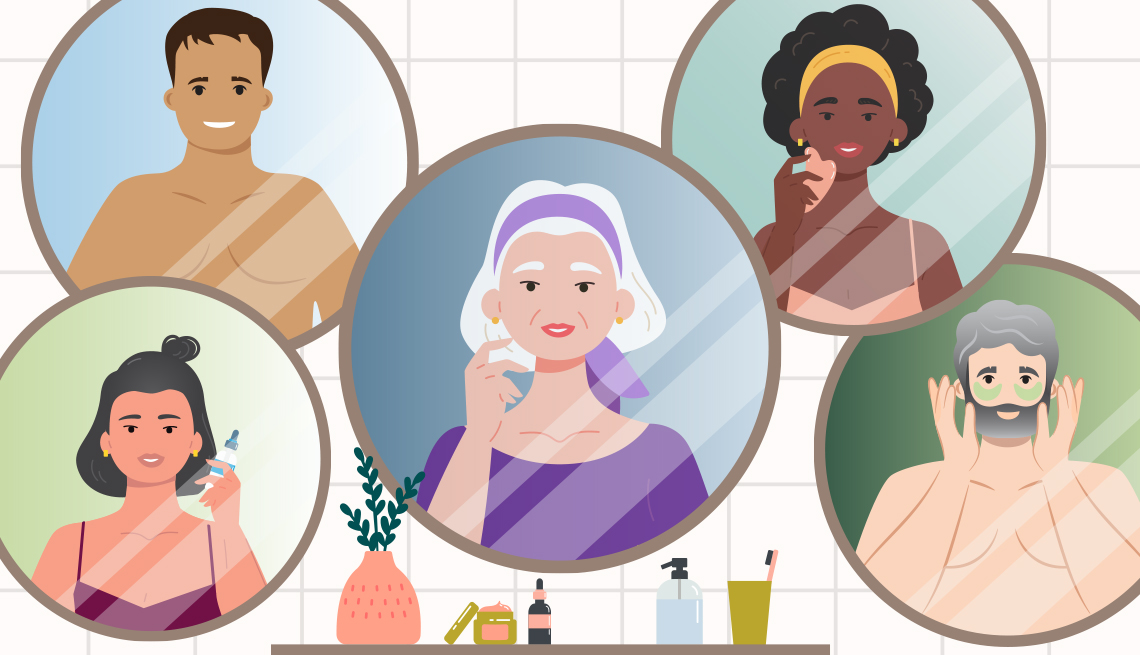
9 body parts to examine in your bathroom mirror
- Select a language for the TTS:
- UK English Female
- UK English Male
- US English Female
- US English Male
- Australian Female
- Australian Male
- Language selected: (auto detect) - EN
Play all audios:

6. POSTURE WHAT TO LOOK FOR: A hunched-over posture that resembles a C instead of an S, a sign of tight or weak muscles or possible vertebral fractures. HOW TO DO IT: Stand sideways before
a full-length mirror, legs hip-width apart and the crown of your head lifted toward the sky. Turn your head toward the mirror. Your ear, shoulder, hip, knee and ankle should all be in
alignment, with a gentle S shape to your back (curving slightly outward behind the lungs and inward near the lower back). If your back is more C-shaped, with your head pushed forward, or has
a hump, try to stand up taller. If you can’t, you may have vertebral fractures due to osteoporosis, says Carol Krucoff, codirector of Integrative Yoga for Seniors teacher training at Duke
Integrative Medicine in Durham, North Carolina. WHO TO CALL: Your health care provider, who may recommend yoga or physical therapy. If they suspect osteoporosis, they might refer you to an
endocrinologist for a bone density scan. 7. HAIR WHAT TO LOOK FOR: Unexplained thinning or patchy hair loss. HOW TO DO IT: Run a hand through your hair and look to see if strands come out.
If they do, use a magnifying glass to examine the ends of the strands. If they are frayed, that probably indicates damage from overuse of a hair dryer or dyeing. If the ends are tapered, it
means otherwise healthy new hair is coming out, a phenomenon that can occur several weeks to months after an intense period of stress or illness, says Sara Wasserbauer, M.D., a past
president of the American Board of Hair Restoration Surgery. Thyroid imbalances, certain medications and an autoimmune disease called alopecia areata can also cause hair loss. WHO TO CALL:
Talk to your family physician, internist or dermatologist, who may recommend topical or oral hair regrowth medications. 8. FEET WHAT TO LOOK FOR: Changes in your arches when you shift your
weight. HOW TO DO IT: Stand barefoot in front of a full-length mirror and turn sideways so your right side is closest to the mirror. Shift your weight onto your right foot, slide your left
foot forward several inches and look at the arch of your left foot. Now shift your weight onto the left foot. If your arch falls flat, “it could indicate that the tendon that holds up the
arch may be weakening,” says Marlene Reid, a surgeon at Family Podiatry Center in Naperville, Illinois. This often occurs in just one foot, so repeat the process on the other side. WHO TO
CALL: Your podiatrist, who may prescribe orthotic inserts and recommend arch-supportive shoes if you’re having discomfort. 9. FINGERNAILS AND TOENAILS WHAT TO LOOK FOR: You may not need a
mirror to see your fingernails and toenails, but they are worth paying attention to. Although many changes to nails can be normal, some are signs of illness. Look for changes in the white
half-moon shape at the base of your nails called the lunula. A change in color or size could mean there is an underlying disease. Also look for changes in nail shape and texture. Nails that
are dimpled or pitted can be a sign of psoriasis, for example. A dark streak running the line of your toenail or fingernail can be a sign of melanoma, a dangerous skin cancer. Blue nails can
mean low oxygen in the blood. For more warning signs, read Surprising Things Your Fingernails Can Reveal About Your Health. HOW TO DO IT: Carefully inspect unpolished fingernails and
toenails. WHOM TO CALL: Your family physician, or in the case of a dark streak, a dermatologist.
